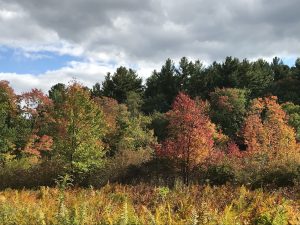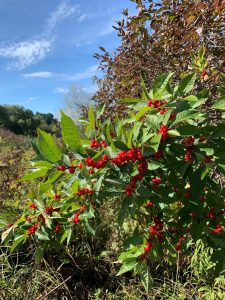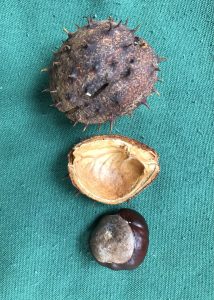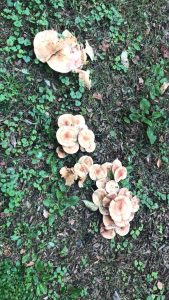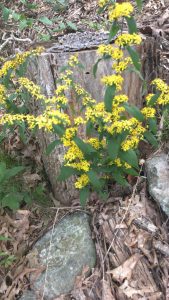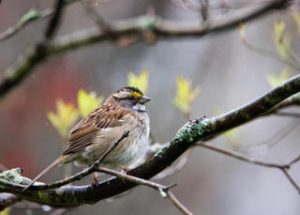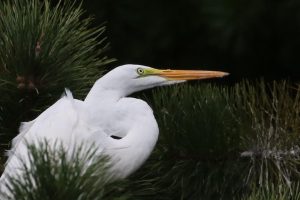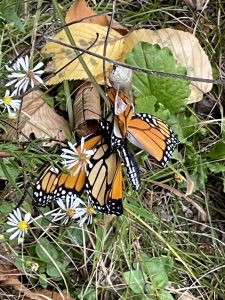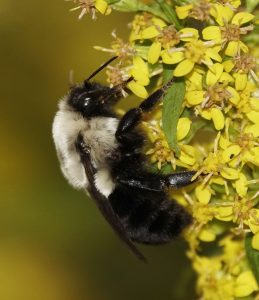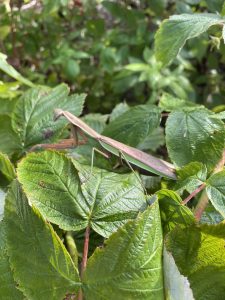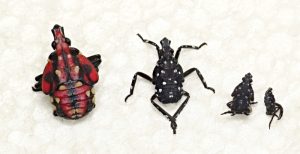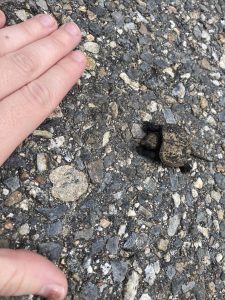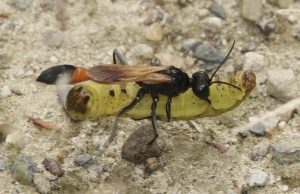Written by Gwyn Loud for the Lincoln Land Conservation Trust. She welcomes your sightings and questions at 781-259-8690 or gwynloud555@gmail.com.
Our landscape is colorful, with lawns still bright green and trees starting to turn their fall colors, somewhat later than usual. We need crisp, sunny warm days and cool clear nights for the foliage to put on its best show, and so far the weather has been too wet and warm. New England has had its fourth wettest year on record and the wet fall may also make the fall foliage colors more muted, with some leaves brown and falling, spotted with fungus. October has given us a number of “perfect” fall days, however, as well as more rain. Red and swamp maples are displaying crimson glory and ash trees, birches and honey locusts are among those turning yellow. Berries on trees and shrubs seem to be especially abundant this fall. Near my house I have enjoyed watching cedar waxwings feeding on juniper berries and several species of birds enjoying berries of Virginia creeper and poison ivy. Naturalist Mary Holland writes about gray dogwood shrubs, “In the fall it is the first of several species of dogwood to have its fruit ripen; as a result Gray Dogwoods are magnets for birds, including migrants, and is visited by over 100 species.”
In the woods, most ferns are turning brown as they die back for the winter, although a few varieties will remain green. Look on the forest floor for the red berries of partridgeberry, eaten by animals such as red foxes, chipmunks, wild turkeys, and mice. It has been an astonishing summer and fall for fungi of all sorts, thanks to all the rain, and mushrooms ripped open on the ground are evidence that many creatures have been nibbling. Along roadsides look for flowers such as common blue wood aster, often covered with busy bees, and hawkweed (yellow). Much of the goldenrod has gone to seed, but blue-stemmed goldenrod is a beautiful late-bloomer. You may come across shiny horse chestnuts on the ground, with their prickly seed case split open nearby. These are not edible chestnuts and they are known in Great Britain as “conkers”, used by children to play a traditional game.
Fall bird migration is well underway, with numerous species of warblers reported. Birders refer to them as “confusing fall warblers”, as their often-drab winter plumage can make identification challenging. October is sparrow month: birders visiting the Food Project fields recently were treated with views of chipping, white-throated, song, Savannah, Lincoln’s, and swamp sparrows. Other migrants of note reported include American pipits, an osprey, a dickcissel, two American kestrels, indigo buntings, ruby-crowned kinglets, wood and Swainson’s thrush, and Eastern phoebes. Flocks of red-winged blackbirds, and grackles are passing through, and flocks of robins can be seen on lawns and mowed fields. 150 green-winged teal were seen in the brook below St. Anne’s, almost certainly a record number for Lincoln. Cormorants were spotted on Fairhaven Bay. Great blue herons will stay here as long as there is open water for them to find food and the same is true for belted kingfishers.
Residents who feed birds are advised to set up feeders by the end of the month so that wintering birds put your “restaurant” on their winter feeding route. White-throated sparrows, which nested farther north, are just arriving to spend the season here and soon we will welcome other winter visitors such as dark-eyed juncos.
On sunny days you could still see a monarch butterfly as it migrates south. I have found a few woolly bear caterpillars; they will spend the winter curled up in a protected place and wait until spring to spin a cocoon and hatch into an Isabella tiger moth. Folklore says that the woolly bears which have broader rust-colored bands predict a warm winter; time will tell! Bees and wasps remain active as long as the temperature is warm, and this is the season when yellow-jackets may join your picnic. Most bumblebees we see now are males, and a few workers but they will all soon die, leaving only the queens to overwinter. Norman Levey photographed a beautiful orange-winged thread-wasted wasp and several people have photographed praying mantises; one was actually eating a spring peeper.
In the bad news department this week, “ The Mass. Department of Agriculture announced that a population of the invasive spotted lanternfly has been found in Fitchburg. Spotted lanternfly is an invasive sap-feeding insect from Asia that was first found in the United States in 2014 in Pennsylvania. While the main host plant of this pest is tree-of-heaven, spotted lanternfly attacks many different trees, shrubs, and vines, and has the potential to impact a broad range of agricultural commodities, including apples, peaches, grapes/wine, hops/beer, maple syrup, and ornamental plants. While individual spotted lanternflies have been found in several different parts of the state over the past several years, this is the first evidence that Massachusetts has a breeding population. See link below for more information. Residents should look for both adult insects (large, gray bugs, about one inch long, with black spots and red underwings) and nymphs (younger nymphs are black with white dots, older nymphs are red with black and white spots).” One action we can take is to remove tree-of-heaven (ailanthus) trees on our property.
More bad news is that Asian Jumping worms are turning up in many places around town. They leave the soil like coffee grounds, depleted of nutrients. For more information, see links below.
On a cheerier note, amphibians have benefited from the wet weather and one can still hear individual spring peepers and gray tree frogs calling. Swamps are full of water and little toads and frogs are plentiful in woods and gardens. This is the season when you might find baby snapping turtles, looking almost like little chocolates, crossing the road as they head for water. Some hatchlings will wait until spring to leave their nest. The baby turtles may trudge as much as a mile to reach water and this is a dangerous time in their lives, risking being hit by cars or eaten by various predators. On Oct. 7 those of us attending the virtual monthly Conservation Coffee learned a lot about the small freshwater jellyfish in Walden Pond (see link below).
Deer are always evident in Lincoln and, sadly, a herd of about eight deer destroyed eighty percent of the pumpkin patch at the Flints’ Farm this fall. One possible explanation is that the coyote population was down in that area this year, allowing the deer to thrive. It was exciting to get a report of another report of a bobcat, this one not far from the Ricci Fields. Last month one was seen near Mt. Misery. As usual in the fall, chipmunks are very vocal, making various chipping, trilling, and chucking calls, often as alarm calls to warn of predators. Chipmunks gather great amounts of nuts and seeds in their cheek pouches and carry the supplies 2.5 feet underground into their tunnel system, where they will over-winter.
Looking skyward, let’s admire the October full moon on October 20. According to the Farmers’ Almanac, “this full Moon is often referred to as the Full Hunter’s Moon, Blood Moon, or Sanguine Moon. Many moons ago, Native Americans named this bright Moon for obvious reasons. The leaves are falling from trees, the deer are fattened, and it’s time to begin storing up meat for the long winter ahead.”
© Gwyn Loud
https://extension.psu.edu/look-out-for-jumping-earthworms
Conservation Coffee-Jellyfish at Walden
https://ag.umass.edu/landscape/fact-sheets/spotted-lanternfly


